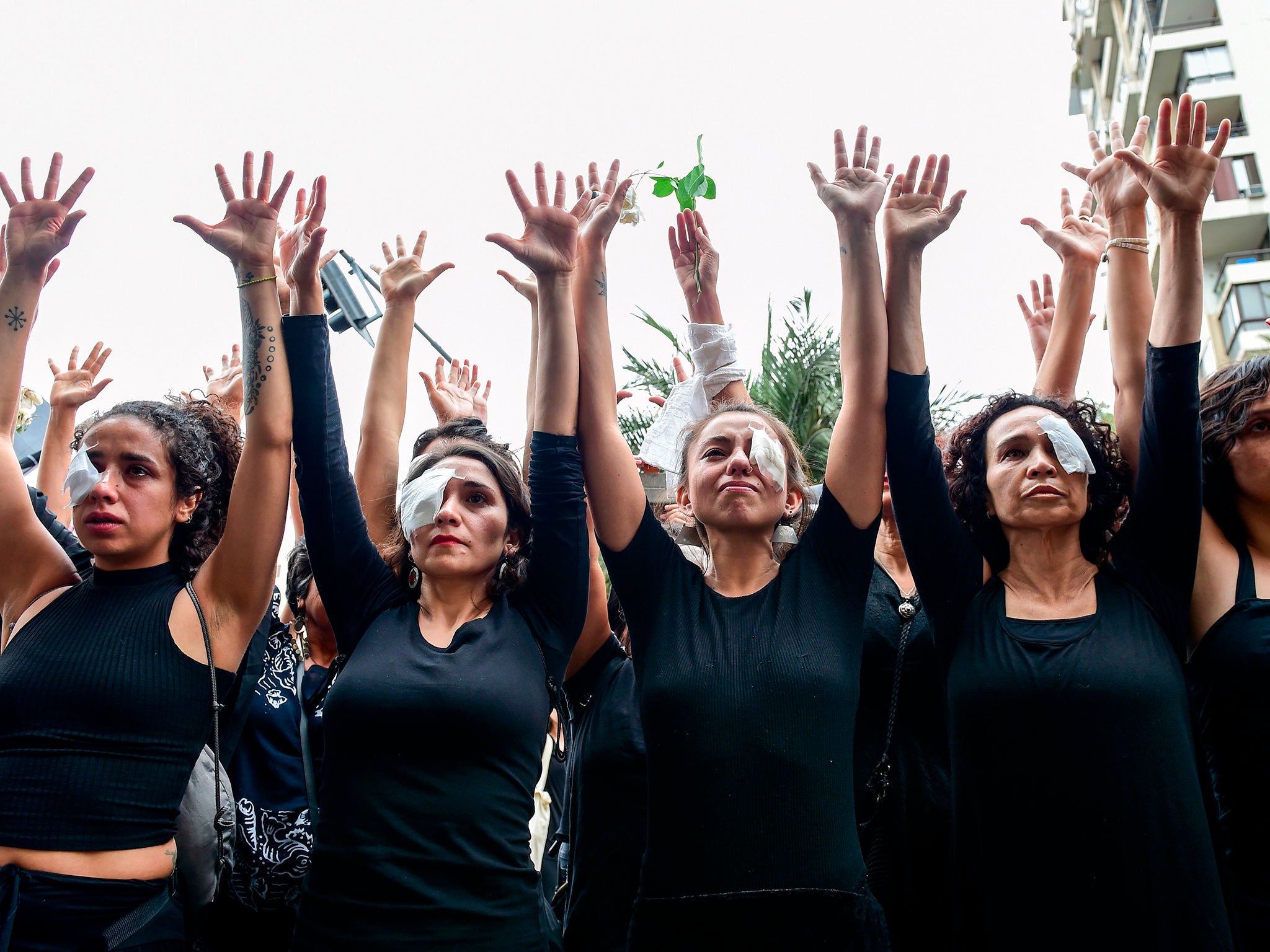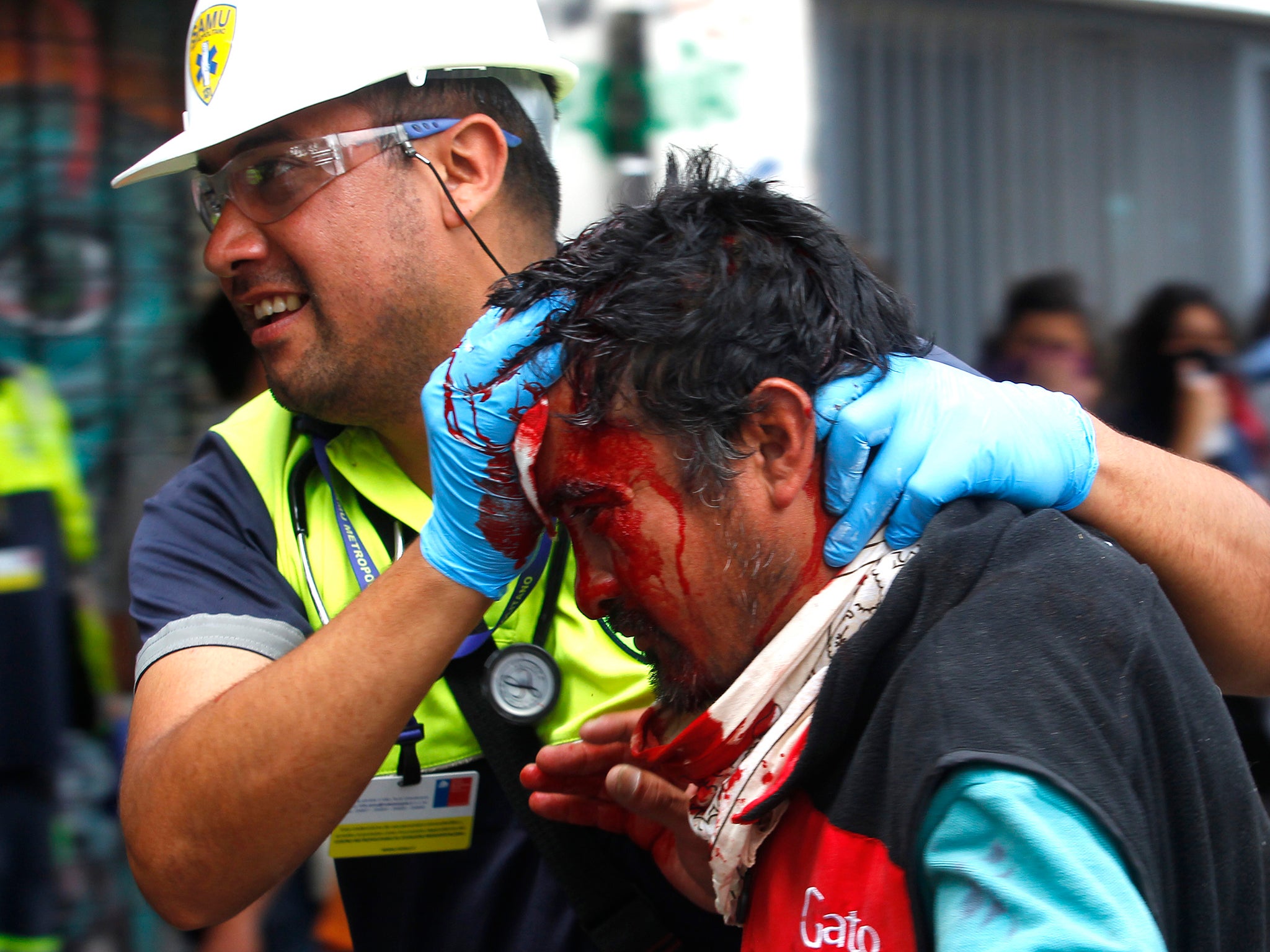Hundreds of Chile protesters suffer ‘severe eye trauma’ from rubber bullets fired by police
‘I felt an impact in my eye, and it all went black. I held up my hands and they shot me three more times’
Your support helps us to tell the story
From reproductive rights to climate change to Big Tech, The Independent is on the ground when the story is developing. Whether it's investigating the financials of Elon Musk's pro-Trump PAC or producing our latest documentary, 'The A Word', which shines a light on the American women fighting for reproductive rights, we know how important it is to parse out the facts from the messaging.
At such a critical moment in US history, we need reporters on the ground. Your donation allows us to keep sending journalists to speak to both sides of the story.
The Independent is trusted by Americans across the entire political spectrum. And unlike many other quality news outlets, we choose not to lock Americans out of our reporting and analysis with paywalls. We believe quality journalism should be available to everyone, paid for by those who can afford it.
Your support makes all the difference.Brandon Gonzalez marched with a group of protesters down the main artery of this Andean capital on 28 October when riot police barricading the way to the presidential palace opened fire with tear gas and hardened rubber bullets.
Mr Gonzalez, who had come from his hospital job equipped with bandages and gauze to treat injured protesters, picked up a stone and hurled it at a police vehicle pumping tear gas into the crowd. Seconds later, he saw an officer about 25 feet away aim a rifle at his face.
“I felt an impact in my eye, and it all went black. I held up my hands so they would stop shooting and then laid on the ground, and they shot me three more times,” said Gonzalez, who works as a hospital assistant. “I thought, they are going to kill me.”
At least 285 people in Chile have suffered severe eye trauma, mostly from hardened rubber bullets and tear gas canisters fired by Chilean security forces at protesters during the month of unrest.
According to the Chilean Ophthalmological Society, that count is expected to rise.
The image of a bandaged eye is now so common it has become a rallying symbol for the protesters in Chile. Even so, the likelihood of such life-altering injury has not deterred demonstrators.
The country’s president, Sebastian Pinera, has struggled to quell nationwide unrest over low wages and a high cost of living, despite conceding to demands for a higher minimum wage and higher basic pension. After protesters upset over a subway fare hike burned Santiago metro stations, Piñera declared the country “at war against a dangerous enemy” and ordered a militarized police force to patrol the streets.
Since then, police have been blamed for at least six deaths, more than 6,300 arrests, and 2,400 hospitalisations of protesters. Public prosecutors in Chile are now investigating hundreds of cases of alleged abuses by police, including torture and sexual violence. The damage to infrastructure and businesses is in the billions of dollars.
The Chilean government’s announcement last week that it would hold a referendum in April to replace the Pinochet-era constitution — one of the key demands of protesters — has also not put an end to the unrest.
Mr Piñera has stood by the police clampdown, claiming the use of force has been justified to maintain order. According to Chilean police, nearly 1,000 officers have also been hospitalised with injuries sustained during protests.
Mario Rozas, director general of the Chilean police, announced that Chile would suspend the use of nonlethal pellets for crowd control and allow police to fire them only in circumstances of “extreme danger”, the same standard used for live rounds.
The change came a week after a New York Times video documentary revealed that Chilean police had blinded protesters with rubber pellets and a few days after a university study found that the pellets contained dangerous amounts of metal.
The number of serious eye injuries at the hands of police has outraged human rights groups and alarmed medical professionals. On 8 November, a university student named Gustavo Gatica was shot by pellets in both eyes and rendered totally blind.
For at least 12 victims, damage to the cornea, iris and optic nerve has been so severe that doctors have had to remove the eye completely.

“A tiny ball this size that hits with such force that the eyeball just opens up like a flower,” Dr Carmen Torres said. “Such damage is very difficult to repair at all.”
Ms Torres is one of a handful of ophthalmologists at Salvador Hospital’s special Eye Trauma Unit, located within tear-gas wafting range of Plaza Italia, the epicenter of the protests.
Since mid-October, she and a team of doctors have received more than 211 patients with severe eye injuries resulting from nonlethal rounds. Over a third of patients have arrived with rubber, metal or ceramic fragments still lodged inside their eyes.
“If the pellet passes even near the optic nerve, it damages the ability to transmit information. And if it passes through the centre of the eye, it destroys it, explodes it,” Torres said. “That’s why we are advocating to stop using these projectiles.”
What police call a “rubber pellet” is only partly rubber. A few days ago, at the behest of the Eye Trauma Unit, researchers at the University of Chile conducted an analysis and found that 80 per cent of the pellet is composed of denser materials, including lead, that increases the projectile’s velocity and makes it as hard as a skateboard wheel.

On a day in late October, the waiting room was crowded with protesters with bandages over one eye. An automotive mechanics student lay on a stretcher worried whether the pellet inside her closed and swollen left eye would leave her blind. A 46-year-old ironworker who was protesting the low minimum wage waited for an implant in his now empty right eye socket. A mother wiped a trickle of blood seeping from her son’s new prosthetic eye as he described the moment a police officer shot him.
The officer lifted the rifle up, said her son, Jesús Emerson Llancan. “He shot me, and then he lowered it again. I spun around from the impact and he shot me again in the back here. But by the second hit, I was in shock. I was bleeding so much from my eye.”
Half a dozen protesters described a similar moment of coming face to face with an officer who aimed for their heads. There’s no visual evidence to back up each of their claims other than the precise location of their wounds. But videos shared over social media have shown Chilean officers pointing weapons directly at people who appear to pose no physical threat. Other videos appear to show officers shooting indiscriminately into crowds of protesters.
“It’s a human rights catastrophe,” said Dr Enrique Morales, President of the Human Rights Department for the Medical College of Chile, who has been tracking eye trauma from the protests.
“If you compare the figures we see of eye injuries in France or in Kashmir or in Palestine, those numbers are much lower,” Mr Morales said, referring to wounded demonstrators in those places.
The United Nations protocol for use of what it calls “less-lethal weapons” states that rounds should be shot at the lower body, away from the head and vital organs. Chilean police protocols on use of force are comparatively vague.
Gonzalo Blumel, Chile’s newly appointed Interior Minister in charge of public security, has denied allegations of human rights abuse by security forces.
“Since the first moment, the government has acted with total commitment, not just on the strict compliance of the protocols on the police and army actions. But also with total and absolute protection of fundamental human rights,” he said.
It is unclear whether the policy change will have any measurable impact on the violence. Last week, Mr Piñera acknowledged there have been some abuses, and said they would be investigated.
“I think there have been excesses, abuses, noncompliance with the protocols, noncompliance with the rules of use of force, bad judgment or crimes,” Mr Piñera said.
When Gonzalez was shot, he said that an officer loaded him into a police van and withheld medical attention until hours later, when they deposited him at a public hospital.
“They were taunting me, saying that I will lose my sight, that I’ll have one less eye,” Mr Gonzalez said.
On Wednesday, Torres operated on Mr Gonzalez, and extracted from his left eye the same black rubber-metal ball she’s seen in other patients. Her prognosis was grim: He will keep his eye, but because of damage to his retinal and optic nerves, he will lose all but five per cent of his vision.
The New York Times

Join our commenting forum
Join thought-provoking conversations, follow other Independent readers and see their replies
Comments